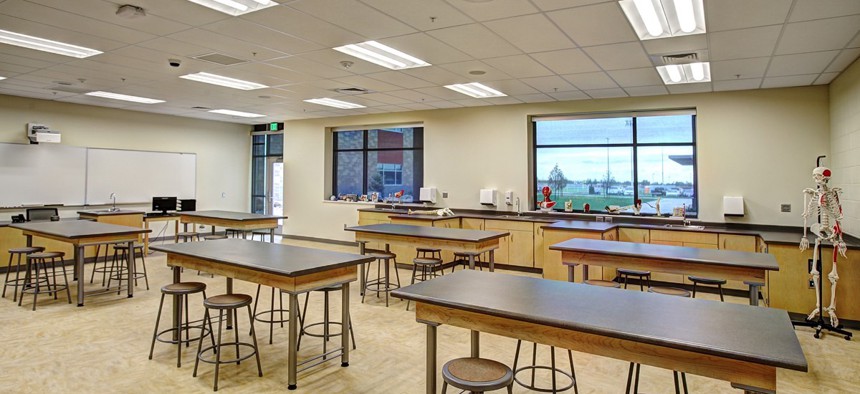Ohio Struggles to Resolve Big Public Education Funding Questions

Since the 1997 DeRolph ruling, school district administrators have lamented the state’s ever-changing models to fund schools.
Ohio’s property tax-based funding model for public education was declared unconstitutional by the state supreme court nearly 20 years ago, but it’s never been fixed, leading local school districts to increasingly turn to income tax levies to supplement their funding.
Out of 191 school districts that now levy income taxes in the Buckeye State, 89 began doing so after the Ohio Supreme Court declared the state’s property tax-based education funding model unconstitutional with a 4-3 decision in DeRolph v. State of Ohio in 1997. Forty-nine have passed levies in the last 10 years.
In the DeRolph case, Justice Francis E. Sweeney wrote for the majority: “By our decision today, we send a clear message to lawmakers: The time has come to fix the system. Let there be no misunderstanding. Ohio’s public school-financing scheme must undergo a complete systematic overhaul.”
Critics argue that the systematic overhaul called for by the high court has never taken place, with state aid often simply being based on the previous year’s amount and each new plan presented in Ohio failing to meet the “thorough and efficient” equity standard decreed by the Ohio Supreme Court in DeRolph.
Each governor of Ohio since the decision has implemented his own plan, but under each one, property taxes have continued to be used as the primary revenue source for funding education, despite the DeRolph ruling forbidding property tax revenue as the primary source for funding.
Gov. George Voinovich—who was governor at the time DeRolph was originally decided and heavily criticized the ruling—introduced his “successful schools” model, which sought to implement funding across the state based on what Ohio’s top-performing schools were spending.
Gov. Bob Taft then implemented his own program, the “building blocks” model, which was designed with funding based on program needs and not student outcomes.
Gov. Ted Strickland overhauled Taft’s solution with his “evidence-based” model, which calculated costs of individual components for a successful education and allocated state resources accordingly.
Strickland’s model was scrapped by current Ohio Gov. John Kasich, who has implemented his “achievement everywhere” program, basing funding on district household income, enrollment and standardized test scores.
An often-heard lament from school district administrators in Ohio since the DeRolph case has been the ever-changing models, with districts barely settling in to the latest standards before they are overhauled and changed again.
In an interview late last week, Damon Asbury, director of legislative services for the Ohio School Board Association, speculated that perhaps more districts are turning to income tax levies because they fear voter fatigue from districts continually asking for more property tax money.
“It has to do with the need for funding sources and people are tired of increasing their property taxes, so depending on the district, they find it easier to get voters to pass an income tax levy,” he said.
The difficulty with property tax operating levies, Asbury said, is that they also need to be renewed every three to five years. Income tax levies more often run continually, he said, or at least don’t need to be renewed quite as often, running for up to 10 years.
Local school district income tax levies in Ohio range from 0.5 percent on the low end, up to 2 percent on the high end. They can be found in 54 of Ohio’s 88 counties, and 191 of Ohio’s 614 school districts. As of July, local school district income tax levies had raised over $144 million this year.
In recent years, Asbury said, districts have been hesitant to ask for additional money with new levies and have seen more success asking voters to renew existing levies. In 2015, for instance, new tax plans had a 59 percent passage rate compared with a 96 percent passage rate for renewals. In 2014, it was 34 percent for new levies compared with 91 percent for renewals.
William Phillis serves as executive director for the Ohio Coalition for Equity & Adequacy of School Funding, a coalition of governments that filed the DeRolph case originally in December 1991. He said reliance on a locality’s ability to fund school districts creates inequity between high property tax districts and low property tax districts.
Moreover, Phillis pointed to vouchers and charter schools taking resources away from local school districts in Ohio to the tune of over $1 billion per year. This has created a situation, he said, where there hasn’t been a per pupil increase in state aid for districts in the last 10 years.
“So the districts have to turn to local revenue,” he said.
Phillis also noted that with the state of Ohio recently reformulating the way agricultural property values are calculated, property taxes have already gone up dramatically for rural farmers. Local school boards don’t want to pile on, he said, so they have been going for income taxes instead.
“Communities with high personal income don’t typically pass or even propose income tax,” he added. “So historically, income school district taxes have come in districts that are relatively low income and agricultural in nature.”
But whether it’s income taxes or property taxes, Phillis said, inequity will persist.
“The best thing that could be done is what the DeRolph decisions pointed to, and that’s that the state has to come up with a greater share of the total revenue for education,” he said. “That’s the bottom line. The greater the state’s share, the greater the equity.”
David DeWitt is a journalist based in Athens, Ohio, and is associate editor for The Athens News. He previously worked at National Journal’s Hotline and The New York Observer’s Politicker.com.
NEXT STORY: FirstNet’s first steps





